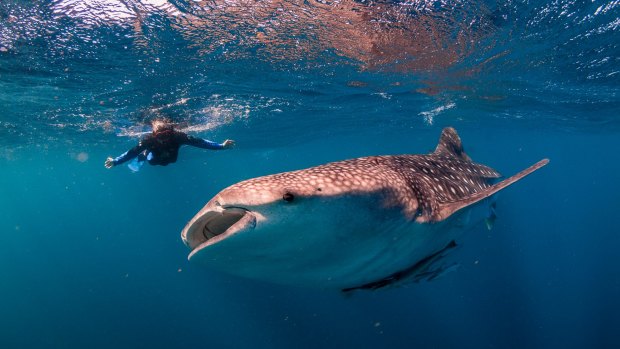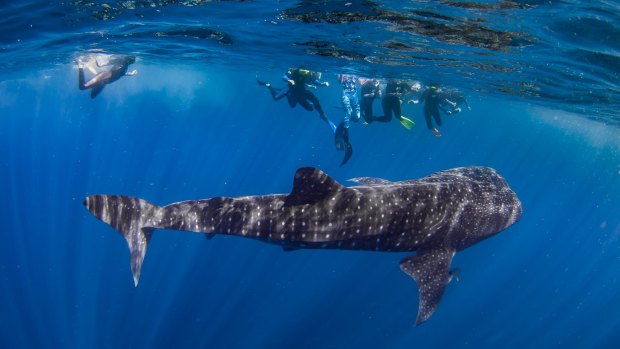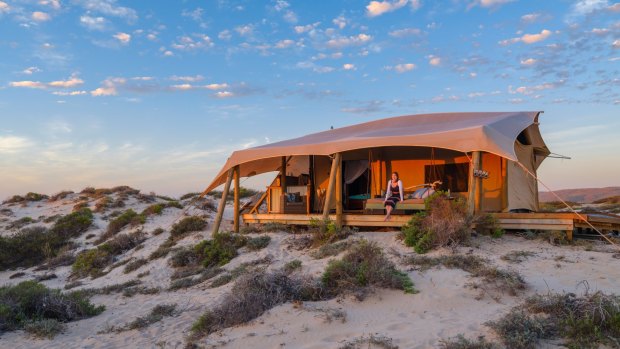This was published 4 years ago
Ningaloo, Western Australia: Swimming with the world's biggest fish in a World Heritage environment

Swimming with Whale Sharks at Ningaloo Marine Reserve.Credit: Live Ningaloo
Ningaloo is a riddle: sodden yet parched, empty yet congested, far-flung yet so very easy to reach.
It's a topographical conundrum, a collision of thirsty earth against a body of water powerless to quench it. Nothing survives here, it seems, except for a hint of withered foliage. Yet look closer and you'll notice creatures darting and loitering in the gorges – echidnas, lizards, dingoes, rock wallabies. Sink your face beneath the water's satin surface and you'll discover a living universe – including, if you're fortunate, the world's biggest fish, the endangered whale shark, flanked by convoys of reef fish heralding its arrival.
And pull into the gateway town of Exmouth (taking care to give way to emu dads crossing the road with their chicks) and you'll find a human population – born-and-breds mixed with blow-ins – that's positively flourishing. Nourished on a diet of sun and fresh air, peace and quiet, they wear that bemused expression of people still getting over the shock of hitting the jackpot. After all, they live in one of Australia's most extraordinary landscapes, and they have it (almost) all to themselves.

Swimming with a whale shark is one of the many appeals of a visit to Ningaloo.Credit: Live Ningaloo
In summer, when the heat is too much for even them to bear, "you can fire a shotgun down the main road and not hit anyone, because all the locals go on holidays", says guide Anne McCarrol.
But it's whale shark season here at the UNESCO World Heritage-listed Ningaloo Coast, and Exmouth is swelling with people who've come to see them. During the last two weeks of May, the town will be given over entirely to these mythological creatures as it celebrates the annual Ningaloo Whale Shark Festival and hosts – for the first time – the International Whale Shark Conference, a gathering of the world's leading whale shark scientists.
Getting to this outpost in Western Australia's remote north-west isn't easy, no matter your species. Whale sharks make the long journey from the chilly Southern Ocean to these balmy waters, where they feast on krill and plankton attracted by spawning coral. Tourists arrive in a similarly languorous fashion, by road or air or a combination of the two. But once here, their perseverance is rewarded with easy access, for Ningaloo's fringing reef is but a shell's throw from where I stand. A handful of strokes from the beach and I'm floating above a coral garden so voluminous it extends 300 kilometres along the coastline and 10 nautical miles seawards.

Sal Salis resort, Ningaloo Reef.Credit:
And while Exmouth's artisanal breweries and jaunty restaurants, and state-of-the-art Ningaloo Centre (where the upcoming conference will be held) are overflowing with patronage during this peak tourist season, the human swarms dissolve easily into the surrounding landscape. They scatter northwards, past 13 transmission towers built by the American and Australian navies in the 1970s to communicate with ships and submarines. (Curiously, the base is named after former Australian Prime Minister Harold Holt, who went missing off the Victorian coast in the late 1960s and was said by conspiracy theorists to have been picked up by a submarine; I wonder, distractedly, if the whale sharks are also tuned into the towers' frequency.)
The road curves southwards on the headland, passing the campsite recently bought by WA mining magnate Andrew Forrest and said to be readying for a resort-style makeover. Not far from Vlamingh Head Lighthouse lies the boundary of the Cape Range National Park, a protected area carved out from surrounding cattle country. This is a jagged landscape, a ruddy promontory lapped by a stripe of neon blue sea; it is the yin to Ningaloo's yang.
Fittingly, this stretch of coast doesn't differentiate between visitors; you can stay at a variety of accommodations in town and take day trips out to the park and the reef; pitch a tent at one of the rudimentary campsites tucked into the dunes right beside the ocean (warning: sites sell out fast in peak season); or, as I'm doing, check into the park's only privately-operated camp, Sal Salis Ningaloo Reef.
Like those fleeting whale sharks, this tented eco-camp disappears almost entirely outside of the tourist season. It's folded and tucked and wrapped against the elements – cyclones are a risk – until next year, when it blooms again, almost imperceptible against the dunes.
From my own tent I can just glimpse that streak of aquamarine beyond the sandbanks. I leave the flaps open so that at night a southerly breeze refreshes the space. In the morning, I find dark tracks imprinted on white sand: the soft indentations of field mice and kangaroos, the extravagant swirls of blind worms beneath the boardwalks.
Offshore, I drift across acres of gently waving coral and, in the hinterland, find evidence that earth and water were indeed once connected: the limestone here is embedded with marine fossils. But the greatest surprise lies beyond the reef: whale sharks, gathering for a banquet.
Guided by spotter planes, our boat locates one of these creatures; I slip into the water and dip my mask beneath the surface. The world's biggest fish emerges from its indigo underworld as though from a dream, a colossus accompanied by the tiniest of golden trevallies. This whale shark exemplifies Ningaloo's paradox, I realise, for it's a fish that also bears the name of a mammal, a shark-shaped monster that's surely incapable of violence, a contradiction of stripes and spots quivering like sunray prisms on ashen skin. It is an enigma, gliding cold-blooded against the ocean's warm current.
FIVE MORE THINGS TO DO IN NINGALOO
SNORKEL WITH HUMPBACKS
Whale sharks aren't the only impressive visitors to Ningaloo Reef. Humpback whales arrive about June on their northwards journey from Antarctica and stay until about November when they set off for the tropical waters around Broome. Humpback whale-swimming tours were launched as part of a trial in 2016, and have been confirmed again for 2019 and 2020. See liveningaloo.com.au
OBSERVE NESTING TURTLES
Three of the world's seven marine turtle species nest on the beaches and islands in Ningaloo Marine Park from about November to March each year. Search for turtles during a kayak and snorkel adventure in the Bundegi Sanctuary Zone in Exmouth Gulf, or join a night tour to observe nesting turtles in the dunes. See visitningaloo.com.au/tours
SET SAIL
The reef is all yours as you take a day-long cruise through Ningaloo Marine Park. Cruises run from March to December; expect to see dolphins, dugongs, manta rays, marine turtles, reef sharks – and, in season, whale sharks and humpbacks. See sailningaloo.com.au
GET A BIRD'S EYE VIEW
To best appreciate the magnitude and beauty of this region, take to the sky in a microlight and behold the colour-clash occurring below as the craggy Cape Range National Park collides with the turquoise waters of Ningaloo Reef. With luck, you'll spot a variety of marine creatures. See birdseyeview.net.au
CRUISE UP THE CREEK
View the red limestone walls rising sheer from the shores of Yardie Creek as you cruise upriver. Guided commentary illuminates the environmental, cultural and Indigenous history of this part of Cape Range National Park; keep your eyes peeled for black-footed rock wallabies and nesting ospreys. See yardiecreekboattours.com.au
TRIP NOTES
Catherine Marshall was a guest of Tourism Western Australia.
MORE
FLY
Qantas operates regular daily flights to Perth from major Australian cities, with onward connections to Exmouth. See qantas.com.
DRIVE
Avis Australia is offering reduced drop-off fees on one-way rentals between Perth and Exmouth in an effort to make the region more accessible and affordable. The promotion is effective for bookings between April and October 2019 and 2020. See avis.com.au and australiascoralcoast.com.
STAY
Sal Salis is open from March to October; rates start at $900 per person per night based on a two-night minimum stay and include accommodation with eco-en suite bathroom, chef-prepared meals and snacks as well as drinks from a select open bar, national park entrance fees and guided activities. See salsalis.com.au.
Campsites can be booked online through WA's Parks and Wildlife Service. See dpaw.wa.gov.au
SNORKEL
Live Ningaloo offers small-group, full-day whale shark swimming tours (maximum of 10 guests) for confident swimmers aged 10 and older. Tours run between March and August, cost $550 per person and include spotter plane guidance, coral reef and ocean swims, wetsuits and snorkelling equipment and lunch. See liveningaloo.com.au.
LEARN
Exmouth's Ningaloo Whale Shark Festival runs from May 24 to 26, 2019, followed by the International Whale Shark Conference from May 28 to 31. See visitningaloo.com.au and iwsc5.info
Sign up for the Traveller Deals newsletter
Get exclusive travel deals delivered straight to your inbox. Sign up now.